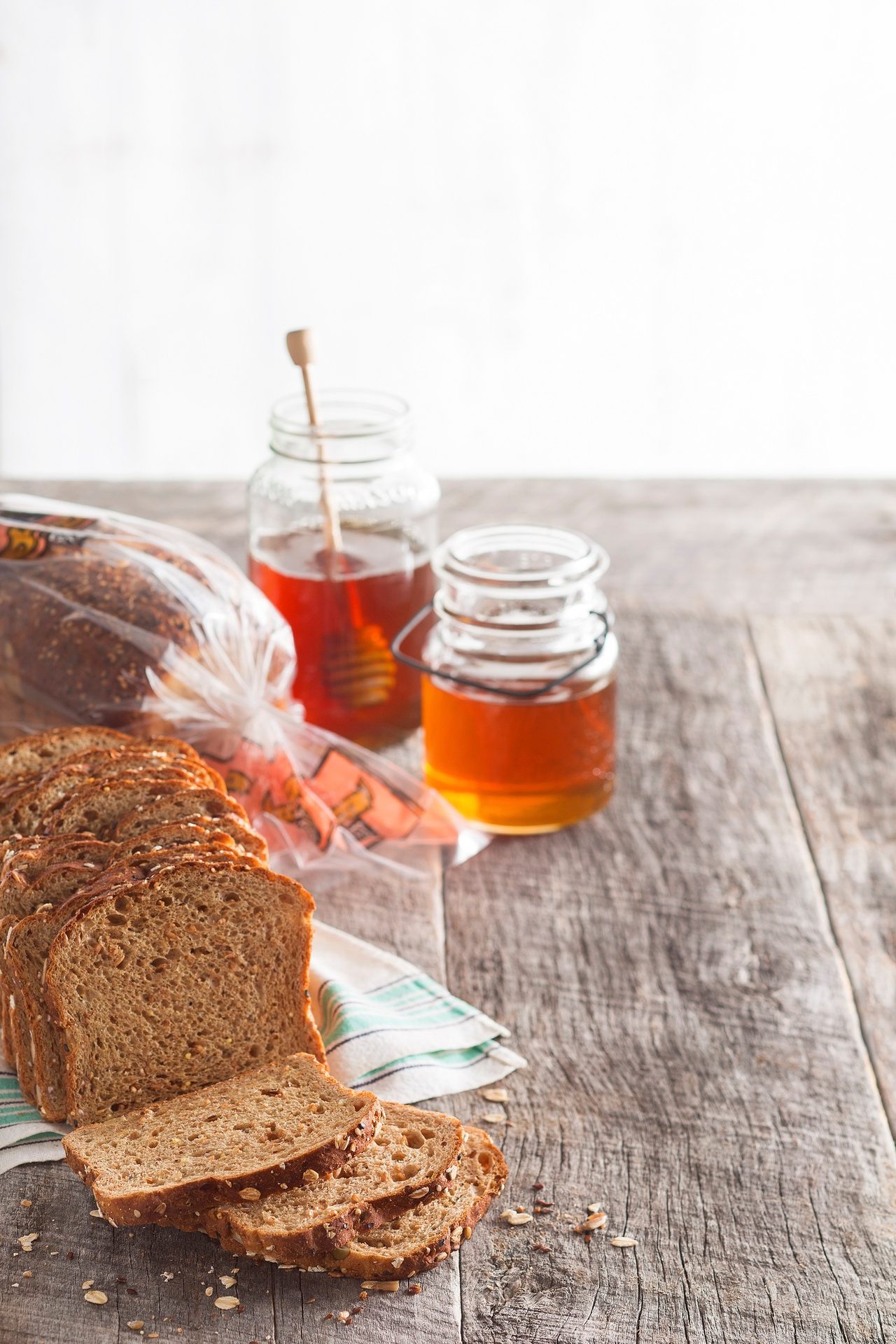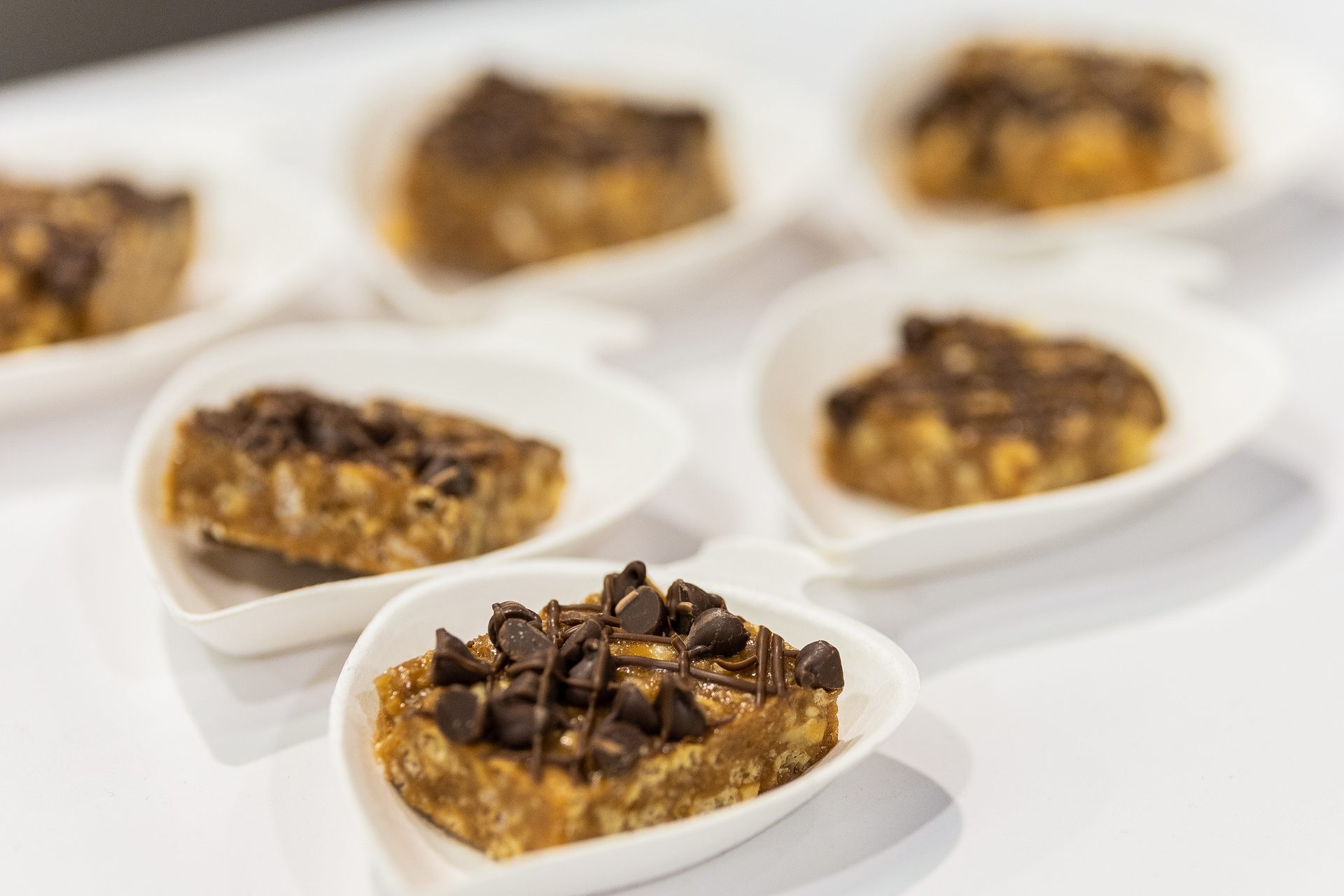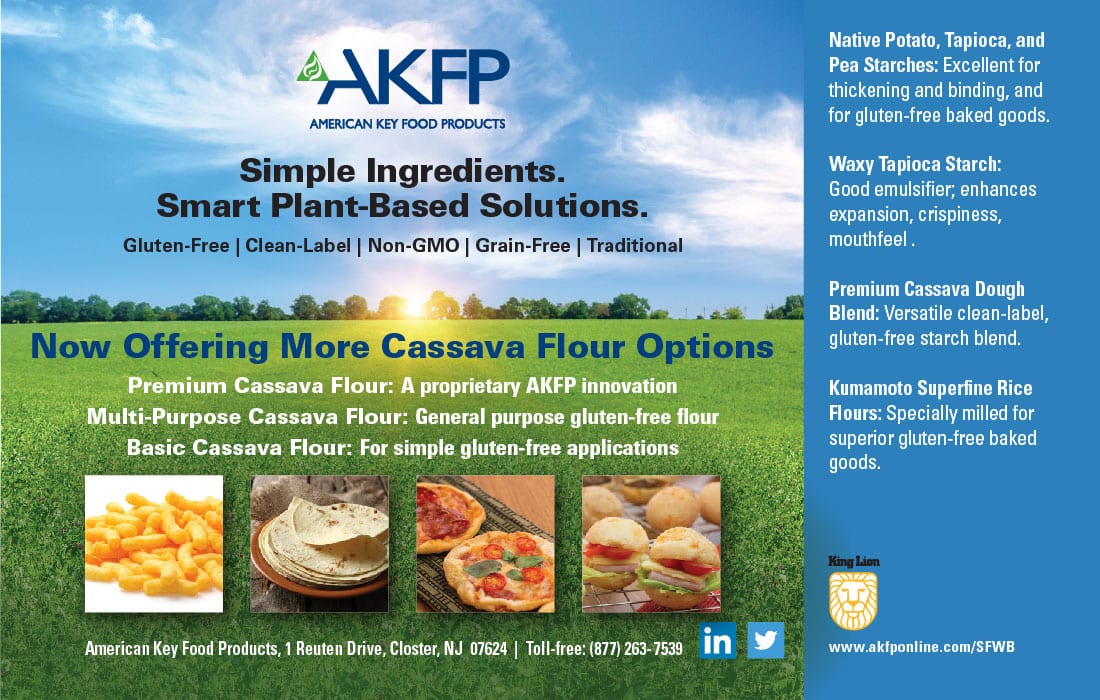Grain alternatives
ingredients
The BOTTOM LINE
- Consumers want lower-sugar snacks and baked products.
- Balancing flavor, texture, and experience with lowered sugar is tricky
- Honey’s popularity is increasing, thanks to its clean-label status
Against the grain
Interest in health and well-being is driving consumer interest in grain-free snack and bakery buys.
Joyce Friedberg, Contributing Writer
You might be seeing more food products with terms like grain alternatives, but what does this mean and what is driving consumer interest? According to Sean Liu, research leader at the U.S. Department of Agriculture’s (USDA) Functional Foods Research Unit in Peoria, IL, “Alternative grains are foods that can replace any of the three major grains: wheat, corn, and rice. These substitutes do not have to be grains themselves; they can be legumes and seeds as well.”
According to research shared by Paula Labine, marketing director, milling and baking solutions, ADM, nearly two in three global consumers (64%) are taking a proactive approach to their health. Looking at data provided by the USDA, approximately 7% of the American population has celiac disease or is sensitive to gluten. Similarly, 10% to 35% of all Americans are either diabetic or prediabetic and must monitor their blood sugar levels. With the increasing number of consumers wanting or needing a healthy diet, this is creating demand for more grain alternatives and gluten free options.

SPONSORED BY
New grain alternatives
“Many companies are responding specifically to the call for gluten-free options in the snack and bakery category,” notes Lindsay Morgan, senior director of product marketing, Ardent Mills. “Since the majority of grain alternatives and pulse ingredients are naturally gluten-free, they are growing in popularity especially within the plant-based and gluten-free market categories.” Ardent Mills observed these trends and recently introduced new gluten-free products to both the U.S. and Canadian markets. Morgan shares the details:
- Gluten-free All-Purpose Flour: suited for retail bakeries, wholesale bakeries and foodservice operators, this formula can be used as a one-to-one replacement for conventional flour in most recipe applications without compromising on taste, texture, or functionality
- Gluten-free Pizza Flour Blend: this blend makes it easy for foodservice and pizza chain operators to deliver fresh, great tasting, gluten-free crusts, including thin, flatbread, and pan pizzas

Courtesy of Ardent Mills
Additionally, consumer interest in keto-friendly options has grown. To address this, Ardent Mills created a line of Keto-certified Net Carb Flour Blends using alternatives grains and ingredients. According to Morgan, these blends are ideal replacements for conventional flour that do not compromise taste, functionality, or consumer preference. The products are non-GMO, keto-certified, dairy-free, vegan, have no added sugar, and are made primarily from blended grains.
- Keto-friendly Flour Blend: for bread and bakery manufacturers, Ardent Mills offers this blend for a broad range of breads and baked goods. A proprietary functional system, it was formulated to achieve the right balance of dietary fibers and grains without nuts or nut flour and does contain gluten, which allows customers to run on their current equipment without significant changes. Applications include bagels, pita, buns and rolls, cakes, croissants and pastries, cookies, crackers, tortillas, and pan breads
- Keto-friendly Pizza Mix: developed for foodservice and pizza chain operators, this easy-to-use mix was designed for simple back of shop operations and is suitable for most crust formats (i.e., thin crust, thick crust, deep-dish, flatbreads, breadsticks, etc.) while still providing a great-tasting pizza experience with texture and crunch.

Courtesy of National Honey Board
Catherine Barry, vice president of marketing, National Honey Board, Erie, CO notes that using a natural sweetener is the cost of entry, and consumers are starting to understand there is a difference in how natural sweeteners are made. With honey, bakers and snack food manufacturers are using an ingredient made by bees in a beehive. Purchasing products with honey helps support beekeepers in their efforts to maintain healthy honeybees. It also adds an emotional element to the purchase of a product made with honey; combine that with a flavor that everyone loves, she says, and you have a powerhouse sweetener that can enhance any bakery or snack food formula.
“Although honey has been around for thousands of years, its growing use in snack foods and baked goods has led to innovative new uses. In food bars, product developers are using honey as a clean label sweetener that binds ingredients,” explains Barry. “This multi-functional use allows food manufacturers to reduce the amount of ingredients used and ensure their ingredient listing is clean. In bread formulations, bakers are taking advantage of honey’s humectancy to ensure their crumb stays moist longer. Honey also performs exceptionally well as a flavor-masker in gluten-free formulas that use non-traditional flours that may carry off flavors.”
ADM has recently launched ADM’s HarvestEdge Gold Sorghum. Sorghum is an ancient grain and HarvestEdge Gold sorghum is a special white variety with a sweet, nutty flavor and light color that is also responsibly sourced, certified gluten-free, and non-GMO, explains LaBine.
“Our sorghum is grown in the U.S., sourced from farmers within a 100-mile radius of our certified gluten-free Dodge City, Kansas mill where it is processed. Sorghum is an ideal crop for arid Kansas, as it requires low inputs such as water. We work closely with our sorghum growing partners in implementing regenerative agriculture practices that reduce environmental impact.” This new ingredient can help bakers create multigrain breads, cereals, crackers, and cookies as well as gluten-free products.
The company also offers NutriStem, a portfolio of wholesome ingredients including beans, pulses, ancient grains, and seeds that are packed with protein, fiber, vitamins, and minerals. LaBine shares the details: “Our beans and pulse ingredients are available in raw and pre-gelled forms and are suitable for a wide variety of applications, like energy bars, extruded snacks, pastries, and cereals. NutriStem seeds include chia, flax, hemp, pumpkin, and sunflower. NutriStem ingredients also have the benefit of supporting clean label targets with transparent sourcing and certifications such as organic, non-GMO, gluten-free, free from allergens, as well as a clean taste and neutral color.”

Courtesy of ADM
New uses
With ancient grains making a comeback, Mathew Schueller, director of marketing insights and analytics, Ardent Mills, provides perspective on which grains are popular and those grains they believe will continue to grow: “Quinoa and chickpeas will remain consumer favorites; however, we anticipate the next frontier of ancient and emerging grains to include the likes of teff, amaranth, buckwheat, and millet.”
“If we look at the rate of inclusion in the bakery category, buckwheat shows the strongest growth,” Schueller continues. “If we look at the impact that the ingredient has on consumer purchasing intent, quinoa, chia, oat flour, buckwheat, chickpea flour, and barley are taking the lead according to Ardent Mills proprietary research. We anticipate this to be fueled by consumers’ growing desire for healthier or perceived healthier options, the overall eating experience and greater diversity in their diets.”
Schueller concludes, “We have also seen increased interest in millet and sorghum following the UN’s naming 2023 the ‘Year of Millets.’ Both millet and sorghum flours make excellent substitutions for wheat when making gluten-free baked goods and bread. Like other alternative grains, millets are popular for their perceived health benefits such as added protein and fiber.”
Morgan outlines some potential uses for both the tried and true and upcoming grain alternatives:
- Quinoa: there are many benefits to quinoa, including that it is inherently gluten-free and non-GMO, is an excellent source of folate, and is a good source of fiber, thiamine, riboflavin, and iron. Quinoa can be used in many applications such as cereals, bars, and pasta
- Chickpea: chickpea is also inherently gluten-free and non-GMO, is an excellent source of folate, and it is a good source of fiber and thiamine. Chickpeas are a versatile ingredient that can be used in crackers, cookies, pizza crusts, and snacks
- Millet: millet is a gluten-free grain with a mild flavor that can be used whole as a topping or as an inclusion in traditional or gluten free multigrain style breads, buns, and rolls. As a flour, it is popular in gluten-free breads, wraps, and flatbreads. Millet is a good source of fiber, thiamine, riboflavin, and niacin and has a broad range of uses including breads, cereals, pizza crust, cookies, and snacks
- Buckwheat: buckwheat is a pseudo grain that is related to rhubarb. A naturally gluten-free ingredient, buckwheat is a good source of fiber, riboflavin, and niacin. Its flaky texture make it best suited for pancakes, waffles, pastry crusts, cookies, and crackers

Courtesy of Almond Board of California
Lanier Dabruzzi, MS, RD, LD, director of food innovations and institutional markets, United Sorghum Checkoff Program, notes that sorghum checks many of the boxes of what consumers are looking for in their foods: “It is an antioxidant and fiber rich ancient grain that is naturally gluten-free and non-GMO. Due to sorghum’s unique carbohydrate and protein cross-linkages, the grain has the ability to maintain its moisture and textural integrity.”
“There are endless potential applications of almond ingredients to achieve various flavor profiles and textures in creative grain-free snack and bakery formulations.”
— Charice Grace, manager, trade marketing and stewardship, Almond Board of California

Sorghum can be used in a variety of food applications; the whole grain or pearled grain can be cooked. It can be popped similar to popcorn for a crunchy snack. Sorghum flour can be used in a variety of baked goods as a gluten-free alternative, and sorghum flakes are used in cereal and granola bars.
Nuts and seeds are considered grain alternatives. Charice Grace, manager, trade marketing and stewardship, Almond Board of California, notes that in addition to whole almonds or almond pieces, product developers are increasingly utilizing other forms. “There are endless potential applications of almond ingredients to achieve various flavor profiles and textures in creative grain-free snack and bakery formulations,” she says. “For example, almond flour is suited for grain- and gluten-free baking and defatted almond flour, also referred to as almond protein powder, can be used to add plant-based protein to bakery and snack products.”
An added benefit is that almonds have a nutrient profile appealing to health and wellness-focused consumers, with a one-ounce serving of almonds containing 6 g of plant-based protein, 4 g of fiber, 13 g of “good” unsaturated fats, and just 1 g of saturated fat.
All the trends indicate that consumer interest in health and well being is here to stay. Therefore, expect to see more alternative grains and innovative uses in snack and bakery products continue to grow. SF&WB
The company is also launching a Bakers Blend, designed as a replacement for sucrose. “It contains allulose which participates in Maillard, browns and can activate leavening. Allulose burns at a lower temperature than sucrose. To compensate, we have added erythritol to this Baker’s Blend. This creates bulk and suppresses the burn point of allulose. Since both erythritol and allulose are 70% as sweet as sugar, we use a proprietary blend of stevia and monk fruit extracts to bring the blend to parity with sugar. Lastly it contains a blend of natural fibers (soluble tapioca fiber and inulin type fibers) to emulate fat and create mouthfeel,” shares King.
With shoppers increasingly conscious about health, they will seek product choices that provide the nutrition they are looking for without compromising on taste, delivering options that are both nutritious and tasty. SF&WB


